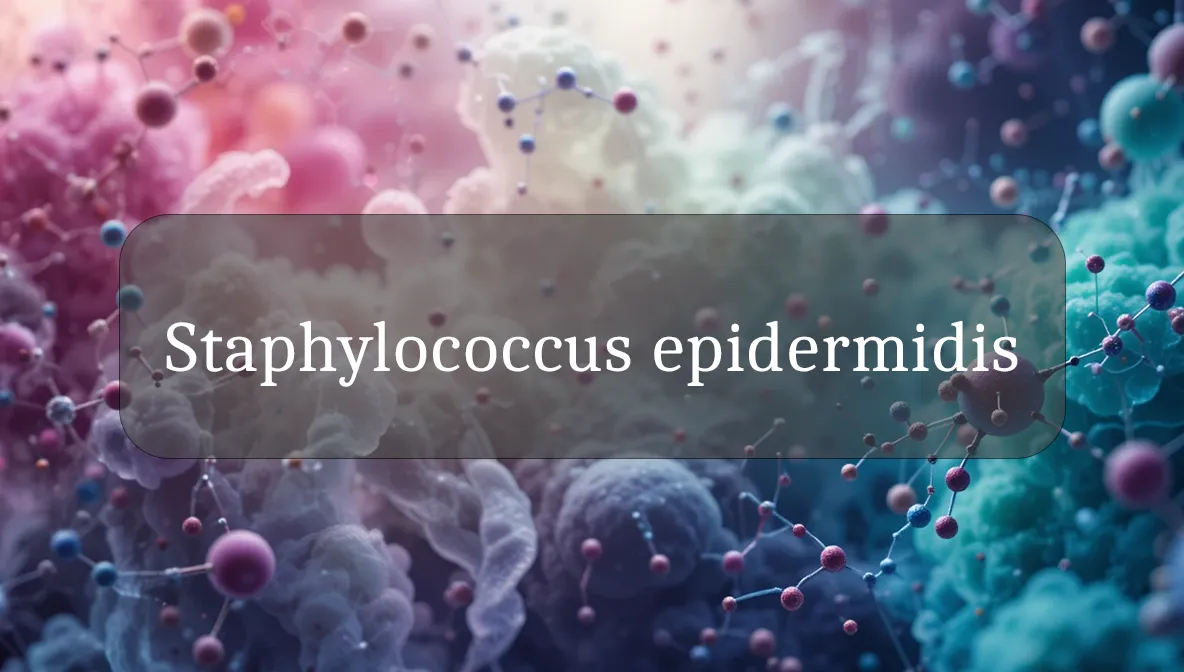Skin’s Friendly Bacterium with a Dual Role
Staphylococcus epidermidis is a common bacterium that lives on your skin, acting as a helpful resident most of the time but occasionally causing issues, especially in medical settings. This guide explains what S. epidermidis is, its role in your health, and practical ways to keep it balanced for healthy skin and overall wellness, all in a clear and actionable way.
Identity and Function
Staphylococcus epidermidis is a Gram-positive, facultative anaerobic (can survive with or without oxygen) bacterium in the Staphylococcus genus. It’s a key member of your skin’s microbiome, thriving in moist areas like the armpits, nose, and forehead. S. epidermidis produces compounds like antimicrobial peptides that fend off harmful bacteria and forms a biofilm that helps it stick to your skin’s surface. Think of it as a friendly guard on your skin, keeping the peace but sometimes causing trouble if it gets into the wrong place.
Health Benefits and Role
S. epidermidis is generally a good neighbor on your skin:
- Skin Protection: It produces antibiotics and peptides that kill pathogens like Staphylococcus aureus, helping prevent infections.
- Immune Balance: It interacts with your immune system, training it to respond appropriately and reducing inflammation, which supports a healthy skin barrier.
- Microbiome Stability: By competing for space and nutrients, it keeps harmful bacteria in check, maintaining a diverse skin microbiome.
- Wound Healing: In small amounts, it may support tissue repair by modulating immune responses.
However, when it overgrows or enters the body (e.g., via medical devices), it can become an opportunistic pathogen.
Natural and Supplemental Sources
S. epidermidis is naturally present on your skin and isn’t consumed or supplemented:
- Natural Sources:
- Skin: Found on all skin types, especially in oily or moist areas like the scalp, face, and underarms.
- Environmental influence: Sweat, poor hygiene, or skin injuries can increase its numbers, while frequent washing may reduce it temporarily.
- Supplemental Sources:
- S. epidermidis is not used in probiotics due to its potential to cause infections. Instead, probiotics like Lactobacillus or Bifidobacterium (oral or topical) support overall skin health, indirectly balancing S. epidermidis.
- Prebiotics: Fiber-rich foods (e.g., garlic, bananas, whole grains) feed gut bacteria, which may improve skin health via the gut-skin axis.
- Probiotics: Topical probiotics with strains like Lactobacillus plantarum or oral probiotics can reduce inflammation and support a healthy skin microbiome.
Good hygiene and a balanced diet help maintain healthy S. epidermidis levels.
Signs of Dysfunction
Overgrowth or misplaced S. epidermidis can lead to health issues:
- Skin Issues:
- Mild irritation: Folliculitis (red bumps around hair follicles) or acne-like breakouts in rare cases.
- Chronic wounds: Slow-healing sores, especially in diabetics, due to biofilm formation.
- Systemic Issues:
- Hospital-acquired infections: S. epidermidis is a leading cause of infections on medical devices like catheters, prosthetic joints, or heart valves, forming sticky biofilms that resist antibiotics.
- Bloodstream infections: Can cause sepsis in immunocompromised patients, with symptoms like fever, chills, or fatigue.
- Endocarditis: Rare infection of heart valves, often linked to medical procedures.
- General Symptoms:
- Localized redness, swelling, or pain at device or wound sites.
- Systemic symptoms like fever or malaise if infection spreads.
If you notice persistent skin irritation, slow-healing wounds, or signs of infection (especially with medical devices), consult a healthcare provider. Cultures or swabs can confirm S. epidermidis involvement.
Supporting Optimal Function
The goal is to keep S. epidermidis balanced to maximize its benefits and minimize risks:
- Maintain Good Hygiene: Wash daily with a gentle, non-comedogenic cleanser to prevent overgrowth without stripping natural oils. Avoid overuse of harsh soaps, which can disrupt the skin microbiome.
- Moisturize Regularly: Use fragrance-free, non-comedogenic moisturizers to support your skin barrier, reducing irritation that promotes S. epidermidis overgrowth.
- Eat a Skin-Friendly Diet: Consume 25–35 grams of fiber daily from fruits, veggies, and whole grains, plus fermented foods (yogurt, kefir) to support gut health, which influences skin balance. Limit sugary foods that can fuel inflammation.
- Avoid Overusing Antibiotics: Unnecessary antibiotics can disrupt beneficial bacteria, allowing S. epidermidis to dominate. Use only as prescribed.
- Care for Wounds and Devices: Keep skin wounds clean and covered. If you have medical devices (e.g., catheters), follow sterile care instructions to prevent S. epidermidis infections.
- Consider Probiotics: Oral or topical probiotics with Lactobacillus or Bifidobacterium may reduce inflammation and support a balanced skin microbiome.
- Manage Stress: Stress can weaken your immune system, increasing infection risk. Try mindfulness, yoga, or light exercise.
These habits promote a healthy skin microbiome, keeping S. epidermidis in check.
Safety, Interactions, and Storage
S. epidermidis is safe in its natural role but problematic in certain contexts:
- Safety: It’s harmless on healthy skin, but poor hygiene, skin injuries, or weakened immunity (e.g., from diabetes or chemotherapy) can lead to overgrowth or infections.
- Interactions:
- Antibiotics can reduce S. epidermidis but also disrupt beneficial bacteria. After antibiotic use, rebuild with probiotics or fermented foods (taken 2–3 hours after antibiotics).
- Harsh skincare products (e.g., alcohol-based toners) can irritate skin, promoting S. epidermidis overgrowth in damaged areas.
- Storage:
- Probiotics or fermented foods used to balance S. epidermidis need proper storage. Refrigerate yogurt, kefir, or certain probiotic supplements to keep cultures alive; check labels for shelf-stable options.
- Precautions:
- If you’re immunocompromised, have medical devices, or chronic wounds, maintain strict hygiene to prevent S. epidermidis infections.
- Seek immediate care for signs of infection (e.g., fever, redness, or swelling around wounds or devices).
Fun Fact
S. epidermidis is like a tiny superhero—it produces its own antibiotics to fight off dangerous bacteria like Staphylococcus aureus, helping keep your skin safe from invaders!
Citations
- National Institutes of Health. (2024). Staphylococcus epidermidis and Skin Microbiome.
- Mayo Clinic. (2023). Skin Infections: Causes and Prevention.
- Cleveland Clinic. (2024). The Role of the Skin Microbiome in Health.
- World Health Organization. (2022). Skin Health and Infection Prevention.
- ScienceDirect. (2024). Staphylococcus epidermidis: Commensal and Pathogen.

